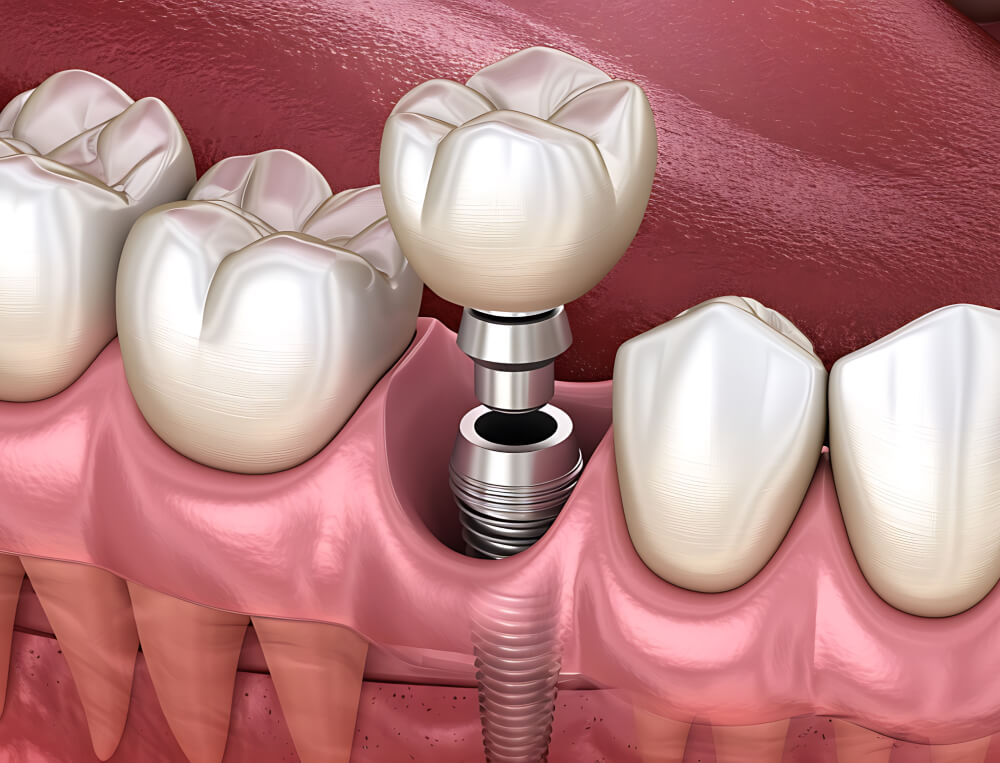Dental implants have revolutionized the way we approach tooth replacement, offering a solution that not only restores function but also closely mimics the natural appearance and feel of real teeth. However, understanding how dental implants work goes beyond the surface. It involves a blend of advanced technology, precise surgical techniques, and a deep appreciation of the body’s healing processes.
Unlike traditional methods, such as dentures or bridges, dental implants integrate with your jawbone, creating a bond that can last a lifetime. This unique aspect is seldom discussed but is crucial for grasping the full potential of this treatment option.
What Are Dental Implants?
Dental implants are a sophisticated dental solution designed to replace missing teeth by mimicking both the appearance and function of natural teeth. Unlike traditional dentures or bridges, which rest on the gums or rely on adjacent teeth for support, dental implants are anchored directly into the jawbone. This is achieved through a titanium post, which is biocompatible and encourages the bone to grow around it—a process known as osseointegration. This unique integration creates a stable foundation for the replacement tooth, ensuring that it stays securely in place and functions like a natural tooth.
An often-overlooked aspect of dental implants is their role in preserving jawbone health. When a tooth is lost, the jawbone in that area begins to deteriorate due to lack of stimulation. Implants provide the necessary stimulation to maintain bone density, preventing the sunken facial appearance that can result from prolonged tooth loss. Additionally, implants are versatile; they can support a single crown, a bridge, or even a full set of dentures, making them a viable option for various dental restoration needs. This adaptability and the ability to preserve natural bone structure set dental implants apart as a superior choice for long-term dental health.
Why Choose Dental Implants?
Choosing dental implants offers numerous benefits that go beyond simply replacing a missing tooth. They provide a long-term solution that supports both aesthetic and functional dental health. Unlike other options, dental implants are designed to integrate seamlessly with your natural bone structure, offering stability and durability that other methods can’t match.
Here are some key reasons why dental implants stand out:
- Natural Appearance: Dental implants are crafted to look and feel like your natural teeth, ensuring a seamless blend with your existing smile.
- Durability: With proper care, dental implants can last a lifetime, making them a cost-effective long-term solution.
- Bone Preservation: Implants stimulate the jawbone, preventing the bone loss that typically follows tooth loss and maintaining the integrity of your facial structure.
- Improved Functionality: Implants allow you to bite, chew, and speak with the same confidence as natural teeth, without the slipping or discomfort that can occur with dentures.
- No Impact on Adjacent Teeth: Unlike bridges, dental implants don’t require the alteration of neighboring teeth, preserving more of your natural tooth structure.
Dental implants not only restore your smile but also play a crucial role in maintaining your overall oral health, making them a superior choice for tooth replacement.
The Dental Implant Process
The dental implant process is a detailed and multi-step procedure designed to ensure the successful integration of the implant into the jawbone and the restoration of the tooth’s function and appearance. Each stage is crucial to the overall success of the treatment, from the initial consultation to the final placement of the crown. Here’s a step-by-step guide to understanding what happens during the dental implant process.
Step #1: Initial Consultation and Planning
The journey to getting a dental implant begins with an in-depth consultation with your dentist or oral surgeon. During this visit, the dental professional will evaluate your oral health, discuss your medical history, and determine if you’re a suitable candidate for implants. This step often includes:
- Comprehensive Oral Examination: This involves a thorough examination of your mouth, including teeth, gums, and jawbone, to assess overall oral health and identify any issues that may need to be addressed before implant surgery.
- Imaging and Scanning: Advanced imaging techniques, such as X-rays or CT scans, are used to create a detailed map of your jawbone structure. This helps in planning the precise placement of the implant.
- Personalized Treatment Plan: Based on the examination and imaging, a tailored treatment plan is developed. This plan includes the timeline, any preparatory procedures (like bone grafting if necessary), and a clear outline of the steps involved in the implant process.
Step #2: Bone Grafting (If Necessary)
In some cases, the jawbone may not have sufficient density or volume to support a dental implant. When this occurs, a bone graft may be necessary to build up the bone in the area where the implant will be placed.
- Why Bone Grafting is Important: Bone grafting provides a strong and stable foundation for the implant by ensuring that the jawbone is thick enough to support the implant post. Without sufficient bone, the implant may fail to integrate properly, leading to complications.
- Types of Bone Grafts: The graft material can come from your own body (autograft), a donor (allograft), or synthetic materials. The choice of material depends on your specific needs and the recommendation of your dental professional.
- Bone Grafting Procedure: This surgical procedure involves placing the graft material into the area of the jawbone that needs reinforcement. Over time, the graft integrates with your natural bone, creating a solid base for the implant. This healing process can take several months before the implant can be placed.
Step #3: Placement of the Dental Implant
Once your jawbone is ready, the next step is the surgical placement of the dental implant. This involves inserting a titanium post into the jawbone, which will act as the root of the new tooth.
- Surgical Procedure: The surgery is typically performed under local anesthesia, although sedation options are available for those who need them. During the procedure, the gum is carefully opened to expose the bone, and a small hole is drilled to insert the titanium post. The post is then secured in place, and the gum is sutured closed over the implant.
- Healing Period: After the surgery, a healing period of several months is required to allow osseointegration, the process by which the implant fuses with the jawbone. This critical phase ensures that the implant is securely anchored and capable of supporting the replacement tooth.
Step #4: Healing and Osseointegration
The success of dental implants largely depends on osseointegration, the biological process where the jawbone grows around the implant, locking it into place.
- What to Expect During Healing: During the healing period, patients may experience mild discomfort, swelling, or bruising, which can be managed with prescribed medications and proper care. It’s essential to follow post-operative instructions carefully to ensure optimal healing.
- Osseointegration Process: Osseointegration typically takes three to six months, depending on the individual’s bone density and overall health. During this time, the implant gradually becomes part of the jawbone, providing a stable and durable foundation for the final restoration.
Step #5: Placing the Abutment and Crown
Once osseointegration is complete, the final steps of the dental implant process involve placing the abutment and the custom-made crown.
- Attaching the Abutment: The abutment is a small connector piece that attaches to the implant post and protrudes above the gum line. This component will hold the crown securely in place. Placing the abutment usually requires a minor surgical procedure to reopen the gum and attach the abutment to the implant. After placement, the gums will heal around the abutment over a couple of weeks.
- Custom-Made Crown: The crown is the visible part of the dental implant and is custom-made to match the size, shape, and color of your natural teeth. Impressions of your teeth are taken to ensure the crown fits perfectly with your bite and blends seamlessly with your smile.
- Final Placement: Once the crown is ready, it is attached to the abutment, completing the dental implant process. The result is a tooth replacement that looks, feels, and functions just like a natural tooth.
The dental implant process is a highly personalized and precise treatment designed to restore your smile and improve your oral health. Each step is crucial in ensuring the longevity and success of the implant, making it a worthwhile investment for those seeking a permanent solution to tooth loss.
What to Expect After Getting Dental Implants
After getting dental implants, you can expect a period of healing and adjustment as your body integrates the new implant into your jawbone. Initially, you may experience some discomfort, swelling, or minor bruising around the implant site. These symptoms are normal and can be managed with prescribed pain medication and cold compresses.
In the days following the procedure, it’s important to follow your dentist’s instructions carefully, which may include eating soft foods, maintaining oral hygiene with gentle brushing, and avoiding strenuous activities. The first few weeks are crucial for healing, so taking care to protect the implant site is essential.
As the implant fuses with your jawbone, you’ll gradually regain full functionality. Regular follow-up appointments will be necessary to monitor the healing process and to ensure that the implant is integrating properly. Once the final crown is placed, you can treat your dental implant like a natural tooth, with regular brushing, flossing, and dental check-ups to maintain its health and longevity.
Are Dental Implants Right for You?
Deciding whether dental implants are the right choice depends on several factors unique to your oral health and personal circumstances. Ideal candidates for dental implants generally have good overall health, a healthy mouth, and sufficient jawbone density to support the implant. If your jawbone is too thin or soft, a bone graft may be necessary before proceeding with the implant.
Additionally, non-smokers and individuals without chronic health conditions, such as uncontrolled diabetes or heart disease, are more likely to experience successful outcomes with dental implants. It’s also important to consider your commitment to oral hygiene, as maintaining a clean and healthy mouth is essential to the long-term success of your implant.
If you’re missing one or more teeth and are seeking a permanent solution that looks, feels, and functions like natural teeth, dental implants may be an excellent option. Consulting with your dentist is crucial to evaluate your specific needs and determine if this treatment aligns with your dental health goals.
Conclusion
Dental implants offer a reliable, long-term solution for replacing missing teeth, combining the best in dental technology and natural aesthetics. With proper care and maintenance, they can restore your smile’s function and appearance for a lifetime. If you’re considering dental implants and want to explore if they are the right option for you, we invite you to take the next step towards a healthier, more confident smile.
Schedule an appointment with us today or call (202) 955-5787 to discuss your personalized dental care plan.


